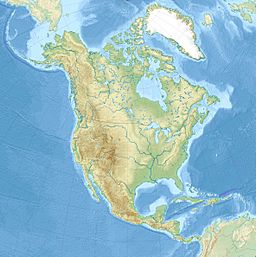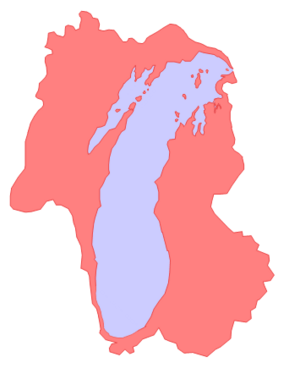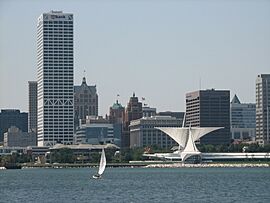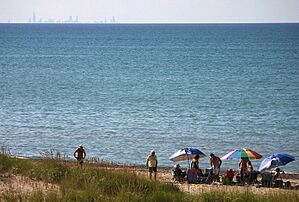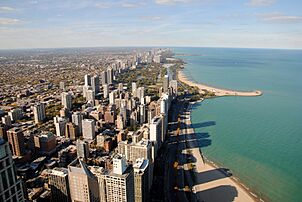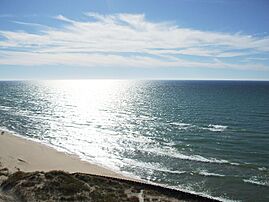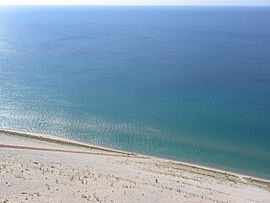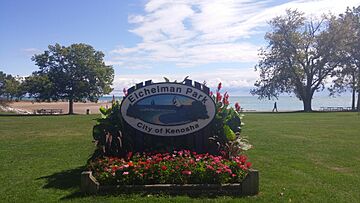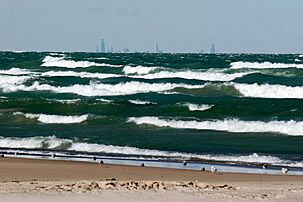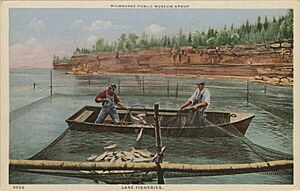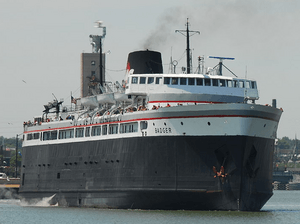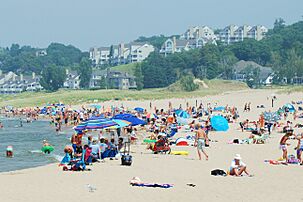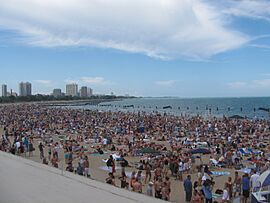Lake Michigan facts for kids
Quick facts for kids Lake Michigan |
|
|---|---|
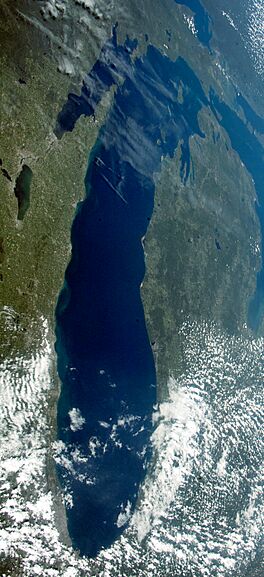
Lake Michigan viewed from the International Space Station (August 19, 2019). Chicago sits at the extreme S.W. of the lake.
|
|
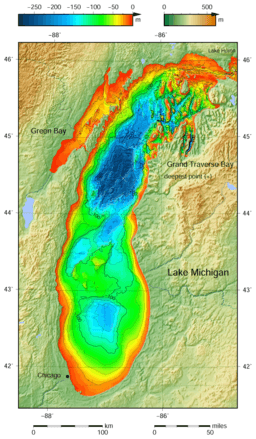
Lake Michigan bathymetric map. The deepest point is marked with "×".
|
|
| Location | United States |
| Group | Great Lakes |
| Coordinates | 44°N 87°W / 44°N 87°W |
| Lake type | Glacial |
| Native name | Ininwewi-gichigami (Ojibwe) |
| Primary inflows | Straits of Mackinac, Fox River, Grand River, Menominee River, Milwaukee River, Muskegon River, Kalamazoo River, St. Joseph River |
| Primary outflows | Straits of Mackinac; also, controlled discharge through locks on the Chicago River (and its North Shore Channel), and Calumet River |
| Basin countries | United States |
| Max. length | 307 mi (494 km) |
| Max. width | 118 mi (190 km) |
| Min. width | 91 mi (146 km) |
| Surface area | 22,404 sq mi (58,030 km2) |
| Average depth | 279 ft (85 m) |
| Max. depth | 923 ft (281 m) |
| Water volume | 1,183 cu mi (4,930 km3) |
| Residence time | 99 years |
| Shore length1 | 1,400 mi (2,300 km) plus 238 mi (383 km) for islands |
| Surface elevation | 577 ft (176 m) |
| Islands | see list |
| Settlements | see list |
| 1 Shore length is not a well-defined measure. | |
Lake Michigan (![]() i/ˈmɪʃɪɡən/ mish-IG-ən) is one of the five Great Lakes of North America. It is the second-largest Great Lake by the amount of water it holds. It is the third-largest by its surface area, after Lake Superior and Lake Huron. To the east, Lake Michigan connects to Lake Huron through the Straits of Mackinac. These straits are about 3+1⁄2-mile (5.6-kilometer) wide and 295-foot (90-meter) deep. Because of this connection, the two lakes have the same water level. Geologists often think of them as one single lake. If counted together, they form the largest freshwater lake in the world by area.
i/ˈmɪʃɪɡən/ mish-IG-ən) is one of the five Great Lakes of North America. It is the second-largest Great Lake by the amount of water it holds. It is the third-largest by its surface area, after Lake Superior and Lake Huron. To the east, Lake Michigan connects to Lake Huron through the Straits of Mackinac. These straits are about 3+1⁄2-mile (5.6-kilometer) wide and 295-foot (90-meter) deep. Because of this connection, the two lakes have the same water level. Geologists often think of them as one single lake. If counted together, they form the largest freshwater lake in the world by area.
Lake Michigan is special because it is the only Great Lake completely inside the United States. The other four Great Lakes are shared between the U.S. and Canada. Lake Michigan is the world's largest lake by area that is fully within one country. It borders the U.S. states of Wisconsin, Illinois, Indiana, and Michigan. Important cities along its shores include Chicago, Illinois; Gary, Indiana; Milwaukee and Green Bay, Wisconsin; and Muskegon, Michigan. In the north, the lake has long bays like Green Bay and Grand Traverse Bay. The name Michigan comes from the Ojibwe word ᒥᓯᑲᒥ (michi-gami or mishigami), which means "great water".
Contents
Lake Michigan's Past
The first known people to live around Lake Michigan were the Hopewell Native Americans. Their culture changed around 800 AD. After that, the Late Woodland Native Americans lived in the area for several hundred years.
When European explorers arrived in the early 1600s, they met the descendants of these groups. These included the Chippewa, Menominee, Sauk, Fox, Winnebago, Miami, Ottawa, and Potawatomi peoples. The French explorer Jean Nicolet is thought to be the first European to reach Lake Michigan, possibly in 1634 or 1638. Early European maps sometimes called it Lake Illinois, named after the Illinois Confederation of tribes.
During the 1640s and 1650s, the Beaver Wars happened. These wars were about the fur trade with European colonies. The Iroquois started these wars, which caused many people to move. Western tribes fled the violence and found safety west and north of Lake Michigan.
The Straits of Mackinac were a key travel route for Native Americans and for the fur trade. On the south side of the straits is Mackinaw City, Michigan, where Fort Michilimackinac (a French fort built in 1715) was located. On the north side is St. Ignace, Michigan, home to a French Catholic mission for Native Americans (founded in 1671). In 1673, Jacques Marquette, Louis Jolliet, and their team explored Lake Michigan. They traveled to Green Bay and up the Fox River as they searched for the Mississippi River. By the late 1700s, Fort Mackinac on Mackinac Island controlled the eastern parts of the straits. This fort was a British and later American military base and fur trade center.
Lake Michigan became an important part of a water route connecting the Saint Lawrence River to the Mississippi River and then to the Gulf of Mexico. French traders set up small ports and trading posts, like Green Bay, in the late 1600s and early 1700s. In the 1800s, Lake Michigan was vital for the growth of Chicago and the Midwestern United States. For example, before the Civil War, 90% of the grain from Chicago was shipped across Lake Michigan. Even after the war, with more railroads, over half of the grain still went by lake.
The deepest part of Lake Michigan was first reached by J. Val Klump in 1985. He was a scientist from the University of Wisconsin–Milwaukee. Klump used a submersible vehicle for his research trip. A 2018 report from Purdue University showed that Lake Michigan's surface temperature has been steadily increasing since 1980. This warming could harm the homes of native fish and other animals, including important game fish.
Lake Michigan's Water
The Milwaukee Reef is a ridge under Lake Michigan. It runs between Milwaukee and Racine on one side, and Grand Haven and Muskegon on the other. This reef divides the lake into northern and southern parts. Water in each part flows in a clockwise direction, moved by rivers and winds. Strong westerly winds push surface water towards the east. This makes the climate of western Michigan milder. In summer, the water on the Michigan side can be 5 to 10 degrees Fahrenheit (2 to 5 degrees Celsius) warmer than on the Wisconsin side.
Even though Lake Michigan and Lake Huron are often seen as separate, they are actually connected and share the same water level. Together, they form the largest body of freshwater in the world by surface area. The Mackinac Bridge is usually seen as the line between them. The main flow of water into Lake Michigan from Lake Superior, through Lake Huron, is controlled by locks managed by the Lake Superior Board of Control.
Lake Facts and Figures
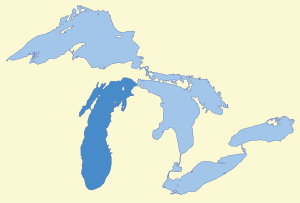
Lake Michigan is the only Great Lake entirely within the United States. Its surface area is 22,404 sq mi (58,030 km2). Of this, 13,237 square miles (34,280 km2) is in Michigan, 7,358 square miles (19,060 km2) in Wisconsin, 234 square miles (610 km2) in Indiana, and 1,576 square miles (4,080 km2) in Illinois. This makes it the largest lake completely within one country by surface area. It is also the fifth-largest lake in the world.
Lake Michigan is the larger half of Lake Michigan–Huron, which is the world's largest freshwater body by surface area. Lake Michigan is 307 miles (494 km) long and 118 miles (190 km) wide. Its shoreline is 1,640 miles (2,640 km) long. The lake's average depth is 279 feet (85 m), and its deepest point is 923 feet (281 m). It holds about 1,183 cubic miles (4,930 km3) of water.
Green Bay in the northwest is the lake's largest bay. Grand Traverse Bay in the northeast is another big bay. The deepest part of Lake Michigan is in its northern half. It is called the Chippewa Basin, named after the ancient Lake Chippewa. This deep area is separated from the South Chippewa Basin by a shallower area called the Mid Lake Plateau.
Islands of Lake Michigan
Most of Lake Michigan's islands are in the northern part of the lake.
- Beaver Island is the largest island in Lake Michigan, covering 55.8 sq mi (145 km2). It is part of a group of islands in Charlevoix County, Michigan. Other islands in this group include Garden Island, Grape Island, Gull Island, Hat Island, High Island, Hog Island, Horseshoe Island, Little Island, Pismire Island, Shoe Island, Ojibwa Island, Trout Island, and Whiskey Island. Fisherman's Island is also nearby.
- The Fox Islands in Leelanau County, Michigan, include North Fox Island and South Fox Island.
- The Manitou Islands, also in Leelanau County, Michigan, are North Manitou Island and South Manitou Island.
- Islands within Grand Traverse Bay include Bassett Island, Bellow Island, and Power Island.
- South of the Garden Peninsula in Delta County, Michigan, you can find Gravelly Island, Gull Island, Little Gull Island, Little Summer Island, Poverty Island, Rocky Island, St. Martin Island, and Summer Island.
- In Big Bay de Noc in Delta County, Michigan, there are Round Island, St. Vital Island, and Snake Island.
- Butlers Island and Sand Island are in Little Bay de Noc in Delta County, Michigan.
- Wilderness State Park in Emmet County, Michigan, has Temperance Island and Waugoshance Island. Ile Aux Galets is also in Emmet County.
- Epoufette Island, Gravel Island, Little Hog Island, and Naubinway Island are in Mackinac County, Michigan.
- Green Island and St. Helena Island are near the Mackinac Bridge, in Mackinac County, Michigan.
- Islands around the Door Peninsula in Wisconsin include Chambers Island, Fish Island, Gravel Island, Spider Island, Horseshoe Island, the Sister Islands, Detroit Island, Green Island, Hog Island, Pilot Island, Plum Island, Rock Island, the Strawberry Islands, and Washington Island. The northern part of the Door Peninsula is actually an island because of the Sturgeon Bay Ship Canal.
- Northerly Island is a human-made area in Chicago, covering 91-acre (37 ha). It is home to the Adler Planetarium and a temporary concert venue.
Connecting to Other Waters
In the mid-1900s, the Saint Lawrence Seaway and Great Lakes Waterway were built. This allowed ocean-going ships to enter the Great Lakes. However, modern, wider container ships cannot fit through the locks on these routes. So, special Lake freighters are used on the lakes that are too big for the ocean locks. Even though the Great Lakes are huge, large parts of them freeze in winter, stopping most shipping. Some icebreaker ships help keep paths open.
Lake Michigan is connected to the Gulf of Mexico by the Illinois Waterway. This route uses the Illinois River and the Mississippi River. Many commercial barges use these waterways. Pleasure boats can also enter or leave the Great Lakes through the Erie Canal and Hudson River in New York. The Erie Canal connects to the Great Lakes at the east end of Lake Erie and the south side of Lake Ontario.
Lake Michigan's Water Level
The lake's water level changes throughout the year. It is usually highest in the summer. The normal high-water mark is 2.00 feet (0.61 m) above a set reference point. In October 1986, Lakes Michigan and Huron reached their highest level ever recorded, 5.92 feet (1.80 m) above this point. In 2020, monthly high-water records were broken for several months in a row.
Water levels are usually lowest in winter. The normal low-water mark is 1.00 foot (30 cm) below the reference point. In the winter of 1964, Lakes Michigan and Huron reached their lowest level at 1.38 feet (42 cm) below this point. Monthly low-water records were set every month from February 1964 to January 1965. The lowest water level ever recorded was in January 2013, when Lake Michigan's average level dropped to 576.2 ft (175.6 m). This was the lowest since records began in 1918. The lakes were 29 in (0.74 m) below their long-term average. Experts said this was due to little snow in winter 2011/2012 and a very hot, dry summer in 2012. Since then, water levels have risen more than 6 feet (1.8 meters) to new record highs.
Drinking Water from the Lake

Lake Michigan, like the other Great Lakes, provides drinking water for millions of people living nearby.
The Great Lakes are managed by the Conference of Great Lakes and St. Lawrence Governors and Premiers. This group includes leaders from the Canadian provinces of Ontario and Québec, and the U.S. states of Illinois, Indiana, Michigan, Minnesota, New York, Ohio, Pennsylvania, and Wisconsin. This group started working in December 2008.
However, the lake still faces environmental challenges. There are Steel mills and refineries near the Indiana shoreline. The Chicago Tribune reported that BP is a major polluter. It has dumped thousands of pounds of raw sludge into the lake daily from its oil refinery in Whiting, Indiana. In March 2014, BP's Whiting refinery spilled more than 1,600 US gallons (6,100 L) of oil into the lake.
Lake Michigan's Shoreline
Beautiful Beaches
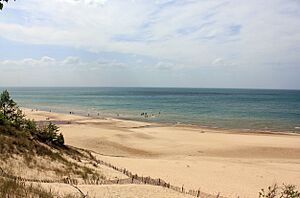
Lake Michigan has many beautiful beaches. This area is often called the "Third Coast" of the United States. The sand is often soft and off-white. It is known as "singing sands" because it makes a squeaking sound when you walk on it. This sound happens because the sand has a lot of quartz. Some beaches have sand dunes covered in green beach grass and sand cherries. The water is usually clear and cool, between 55 and 80 °F (13 and 27 °C), even in late summer. However, westerly winds tend to push warmer surface water towards the Michigan shore in the summer.
The sand dunes on the east shore of Lake Michigan are the largest freshwater dune system in the world. In many places along the shore, the dunes rise hundreds of feet above the lake. You can see large dune formations in many state parks, national forests, and national parks along the Indiana and Michigan shorelines. Some of the biggest and most unique dunes are at Indiana Dunes National Park, Saugatuck Dunes State Park, Warren Dunes State Park, Hoffmaster State Park, Silver Lake State Park, Ludington State Park, and Sleeping Bear Dunes National Lakeshore. Smaller dunes are on the western shore at Illinois Beach State Park. Medium-sized dunes are in Kohler-Andrae State Park and Point Beach State Forest in Wisconsin. A large dune formation is also in Whitefish Dunes State Park in Wisconsin, on the Door Peninsula.
Beaches in Northern Michigan are the only place in the world, besides a few inland lakes there, where you can find Petoskey stones. This is Michigan's state stone.
The beaches on the western coast and the northernmost part of the eastern coast are often rocky, with some sandy areas. The southern and eastern beaches are usually sandy and covered with dunes. This is partly because of the strong winds from the west. These winds also cause thick ice to build up on the eastern shore in winter. The Chicago city waterfront has been developed with parks, beaches, harbors, and marinas. These are connected by the Chicago Lakefront Trail. Where there are no beaches, stone or concrete walls protect the shoreline from erosion. The Chicago lakefront is open for about 24 miles (39 km) along the city's southern and northern edges.
Cities by the Lake
About twelve million people live along Lake Michigan's shores. Many live in the big cities of Chicago and Milwaukee. The economies of many towns in northern Michigan and Door County, Wisconsin, rely on tourism. Many people visit these areas seasonally, especially in summer, for their vacation homes. The southern tip of the lake near Gary, Indiana, has many factories and industries.
Here are some cities on the shores of Lake Michigan:
Illinois
- Chicago
- Evanston
- Wilmette
- Winnetka
- Kenilworth
- Glencoe
- Highland Park
- Lake Forest
- Lake Bluff
- Naval Station Great Lakes
- North Chicago
- Waukegan
- Beach Park
- Zion
- Winthrop Harbor
Indiana
Michigan
- Benton Harbor
- Bridgman
- Charlevoix
- Douglas
- Elberta
- Escanaba
- Ferrysburg
- Frankfort
- Gladstone
- Glenn
- Grand Beach
- Grand Haven
- Harbor Springs
- Ludington
- Manistee
- Manistique
- Menominee
- Michiana
- Muskegon
- New Buffalo
- Norton Shores
- Pentwater
- Petoskey
- Saugatuck
- St. Joseph
- Shoreham
- South Haven
- Traverse City
Wisconsin
- Algoma
- Bay View
- Cudahy
- Fox Point
- Green Bay
- Kenosha
- Kewaunee
- Manitowoc
- Marinette
- Milwaukee
- Mequon
- Oconto
- Port Washington
- Racine
- Saint Francis
- Sheboygan
- Shorewood
- South Milwaukee
- Sturgeon Bay
- Two Rivers
- Whitefish Bay
- Waterford
-
The Milwaukee lakefront
-
Chicago's Oak Street Beach
Parks Along the Shore
The National Park Service manages the Sleeping Bear Dunes National Lakeshore and Indiana Dunes National Park. Parts of the shoreline are also within the Hiawatha National Forest and the Manistee National Forest. The Manistee National Forest section includes the Nordhouse Dunes Wilderness. The Lake Michigan part of the Michigan Islands National Wildlife Refuge is in the lake, as are the Green Bay National Wildlife Refuge and the Wisconsin Shipwreck Coast National Marine Sanctuary.
Many state and local parks are located on the shores of the lake or on its islands:
- Chicago Park District Beaches
- Duck Lake State Park
- Fayette Historic State Park
- Fisherman's Island State Park
- Grand Haven State Park
- Grand Mere State Park
- Harrington Beach State Park
- Holland State Park
- Hoffmaster State Park
- Illinois Beach State Park
- Indian Lake State Park
- Indiana Dunes State Park
- Kohler-Andrae State Park
- Lake Park, Milwaukee
- Ludington State Park
- Leelanau State Park
- Mears State Park
- Muskegon State Park
- Newport State Park
- Orchard Beach State Park
- Peninsula State Park
- Pere Marquette Beach
- Potawatomi State Park
- Racine Zoo
- Rock Island State Park
- Saugatuck Dunes State Park
- Shingleton Management Unit within the Lake Superior State Forest
- Silver Lake State Park
- Traverse City State Park
- Terry Andrae State Park
- Van Buren State Park
- Warren Dunes State Park
- Wells State Park
- Whitefish Dunes State Park
- Wilderness State Park
-
Big Sable Point, Michigan in Ludington State Park
-
Lake view from the Sleeping Bear Dunes National Lakeshore, with people climbing uphill
-
Sleeping Bear Dunes from the Empire Bluffs Trail near Empire, Michigan
-
Eichelman Park in Kenosha, Wisconsin, with Lake Michigan in the background
-
Lake Michigan and the Chicago skyline from Portage, Indiana
Fun Activities on Lake Michigan
Fishing in the Lake
Lake Michigan is home to many kinds of fish and other creatures. Originally, it had fish like lake whitefish, lake trout, yellow perch, panfish, largemouth bass, smallmouth bass, and bowfin, plus some types of catfish.
Over time, changes to the Welland Canal in 1918 allowed sea lampreys to invade the lake. Also, too much fishing caused native lake trout numbers to drop. This led to an increase in another invasive species, the alewife. To fix this, new fish like different kinds of brown trout, steelhead (rainbow trout), coho, and chinook salmon were put into the lake. These new fish helped control the alewife population. This program worked so well that the numbers of trout and salmon grew very fast. This created a big sport fishery for these new fish.
Today, Lake Michigan is stocked every year with steelhead, brown trout, and coho and chinook salmon. Some of these salmon and trout have even started to reproduce naturally in rivers that flow into Lake Michigan. However, several other invasive species, like lampreys, round goby, zebra mussels, and quagga mussels, continue to change the lake's ecosystem. They affect water clarity and how fertile the water is. These changes threaten the health of the native fish populations.
Commercial fishing in the Great Lakes is smaller than ocean fishing. In 2001, the Great Lakes fisheries were worth about $14 million. In Michigan, about 150 Native American tribes have licenses to fish commercially. They catch about half of all commercial fish in Michigan's Great Lakes waters. There are also 45 state-licensed fishing businesses. The main fish caught for sale is the lake whitefish. The yearly catch of whitefish has gone down in recent years.
For sports fishing, people mainly catch salmon, whitefish, smelt, lake trout, and walleye. In the late 1960s, when Pacific salmon were successfully introduced, the charter fishing industry on Lake Michigan grew a lot.
Shipping on the Lake
Like all the Great Lakes, Lake Michigan is used to transport large amounts of goods. In 2002, about 162 million tons of dry goods were moved across the Lakes. These goods included iron ore, grain, and potash. The iron ore, stone, and coal are used in the steel industry. Some liquid and containerized cargo is also shipped. However, most large container ships cannot fit through the locks on the Saint Lawrence Seaway. The total amount of shipping on the lakes has been decreasing for several years. The Port of Chicago has storage for grain and liquid cargo along Lake Calumet. The U.S. Army Corps of Engineers maintains the main part of the Port District, Calumet Harbor.
Lake Ferries
Two ferries carry passengers and vehicles across Lake Michigan. Both connect Wisconsin on the west side with Michigan on the east. From May to October, the historic steamship, SS Badger, travels daily between Manitowoc, Wisconsin, and Ludington, Michigan. It connects U.S. Highway 10 between the two cities. The Lake Express, started in 2004, carries people and cars across the lake between Milwaukee, Wisconsin, and Muskegon, Michigan.
Tourism and Fun
Tourism and recreation are big industries on all the Great Lakes. A few small cruise ships sail on Lake Michigan, including some sailing ships. Many other water sports are popular on the lakes. These include yachting, sea kayaking, diving, kitesurfing, and lake surfing. Passenger steamers have been operating on the Great Lakes since the mid-1800s. Several ferries currently take passengers to various islands, such as Beaver Island and Bois Blanc Island (Michigan). Currently, two car ferry services cross Lake Michigan from about April to November. These are the SS Badger, a steamer from Ludington, Michigan, to Manitowoc, Wisconsin, and the Lake Express, a fast catamaran from Milwaukee to Muskegon, Michigan.
The Great Lakes Circle Tour is a scenic road system that connects all the Great Lakes and the St. Lawrence River. Lake Michigan is also a great place to see ice volcanoes. These cool formations usually appear at the start of the winter season.
-
Lake Michigan beach at Holland State Park in Park Township, Michigan
-
Chicago's North Avenue Beach, Lincoln Park
See also
 In Spanish: Lago Míchigan para niños
In Spanish: Lago Míchigan para niños


